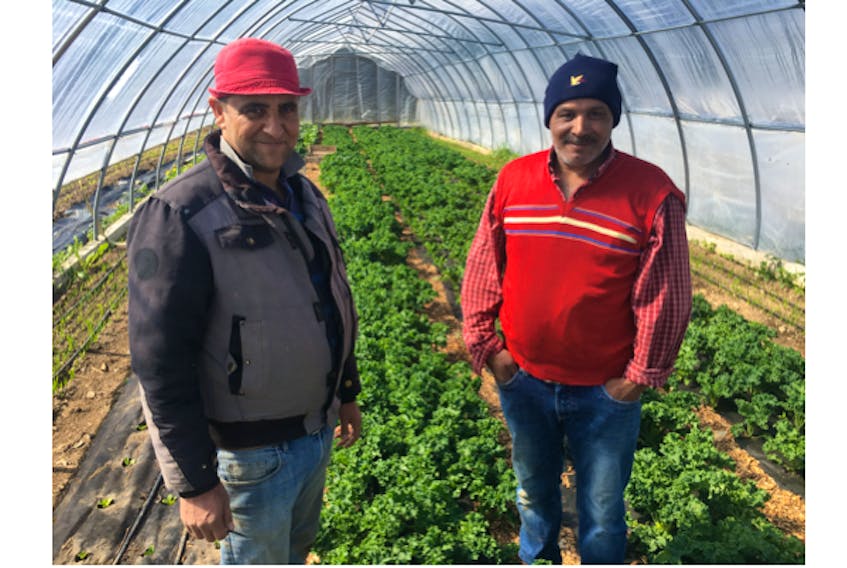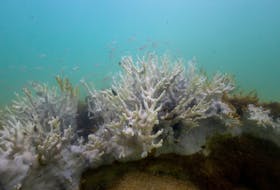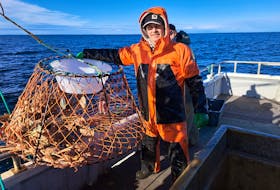ST. JOHN'S, N.L. — The morning sun kisses the vegetable farm and sets the rows of white greenhouses aglow.
There is not a noise to be heard, other than the occasional walking sound.
It’s a world away, in place and peace, from the last ground Nezar Khalif worked.
His acreage in Syria was destroyed — cattle and all — by bombs.

This is the first time in eight years that he has been able to plant vegetables.
“That makes me happy,” Nezar says.
Emaad Al Ktifan is working the land with him.
A former farmer himself, he, too, fled Syria.
Nezar and Emaad are refugees of a civil war that broke out eight years ago and continues today.
More than 360,000 people have died. Another 5.6 million have left the country, according to the United Nations Refugee Agency.
Since the war began, our pages, both print and web, have been peppered with stories about the plight of the displaced Syrians.
I will never forget a wire editor beckoning me to his computer and pointing to the image of three-year-old Alan Kurdi’s lifeless body on a Turkish beach.
The child, his five-year-old brother and their mother all drowned in the Mediterranean Sea on their flight to freedom.
Canada has taken in tens of thousands of Syrian refugees since the war began.
As a journalist and a Canadian, I’ve been keenly interested in how they were faring here.
Emaad and Nezar, who are both from the city of Daraa, arrived three-and-a-half years ago with their families.
Emaad is a father of six.
Nezar has eight children, and will soon have nine.
They live in the St. John’s area.
They see farming as a way to get back on their feet, to put down roots, in the ground and for their families.
“This is our experience, our skills. We like to work at nature. The nature is alive. That’s what I lost in my home country." — Nezar Khalif
Both have dreams of owning an acreage.
“This is our job,” says Nezar. “This is our experience, our skills. We like to work at nature. The nature is alive. That’s what I lost in my home country. I like to start a job here to transplant everything that I was planting in my home country.”
Since April, Nezar and Emaad have been trying to make their dreams grow into reality.
They are part of a program called Bridging the Divide, which connects refugees with farming experience to related opportunities in Newfoundland and Labrador. The initiative is funded by the NL Workforce Innovation Centre.
Through support from the Association of New Canadians and a partnership with Murray Meadows Farm in Portugal Cove-St. Philip’s, Emaad and Nezar are working the field and greenhouses glowing in today’s morning sun.
They are also experimenting with some of their own produce in a corner area, including some seeds from their own country and watermelon. (Yup, they are hoping to grow watermelon in Newfoundland.)
“I come to a country that has special weather,” Nezar says of Newfoundland.
They started at Murray Meadows in April and recently harvested onion, radish, kale and lettuce for local markets.
“I am very happy to sell (vegetables),” says Emaad.
Brian Kowalski owns the farm, and says that thanks to Emaad and Nezar, he’s expecting “a burst of food” in a few weeks.
He lauds their work ethic and problem-solving abilities.
“They are already accomplishing a lot in terms of learning how to farm here,” Kowalski says. “And that’s really what the whole intent was — learning how to farm in this environment.
“It’s been a real joy.”
Earlier this year, I was involved in the SaltWire Network Deep Dive series, “Employment after Immigration.” It explored how to attract, hire and retain more newcomers in Atlantic Canada.
The project showed the vital importance of welcoming people from other countries and encouraging them to stay.
We quoted a 2018 speech by former New Brunswick premier Frank McKenna that pretty much sums it up.
“I don’t think it’s overly dramatic to say the future of Atlantic Canada is at stake,” he said.
Why? Because we have an aging population and youth continue to leave the East Coast to seek employment. Those factors result in low population growth.
Academics and experts see immigration as a way to curb that problem, attract skilled workers to the region and enrich an already-rich culture.
I’m on board with them.
A key to keeping newcomers here is for them to find or create meaningful work.
That’s exactly what Nezar and Emaad are doing.
I can’t wait to taste their watermelons.
Steve Bartlett is SaltWire Network’s senior managing editor. Reach him at [email protected].
RELATED









